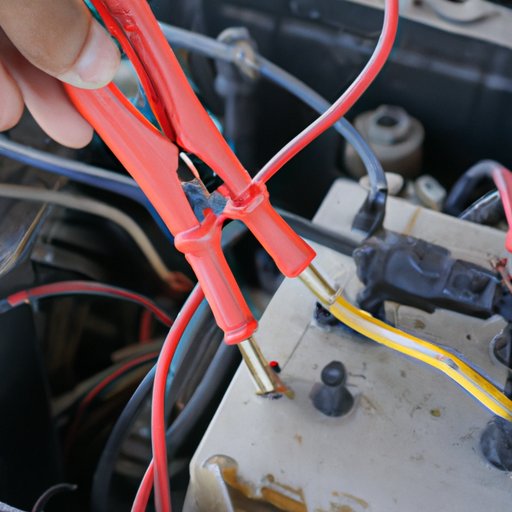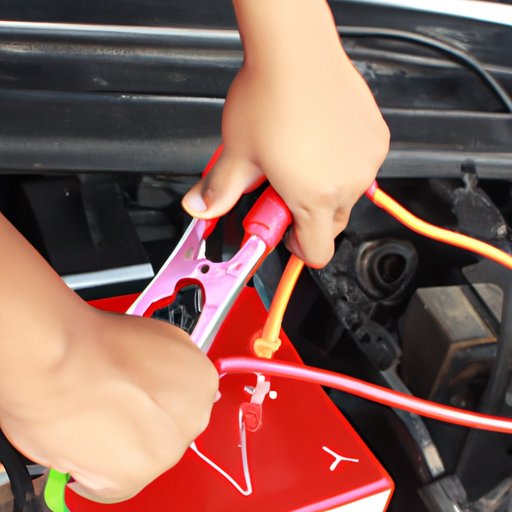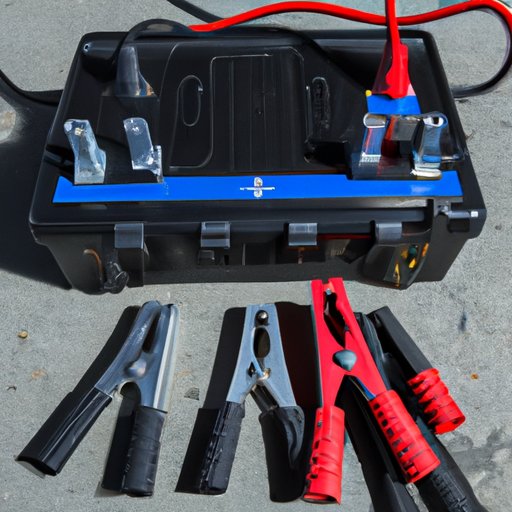Introduction
When you turn the key in your car’s ignition and nothing happens, it’s likely that you have a dead battery on your hands. A dead battery can be a major inconvenience and can put a damper on your plans if you’re looking to get somewhere. Fortunately, it’s possible to jump start the battery and get back on the road. Knowing how to jump start a battery is a valuable skill for any car owner, so read on to learn more about the process.

Check the Battery Cables and Terminals
The first step to jump starting a battery is to check the battery cables and terminals. Loose or corroded connections can prevent your battery from charging properly and will need to be addressed before attempting to jump start it. To inspect the connections, begin by disconnecting the negative cable (black) from the battery terminal. Then, inspect the cable for signs of corrosion, damage, or wear. If the cable looks worn or corroded, it may need to be replaced.
Once the cable has been inspected, reconnect it to the battery and repeat the process for the positive cable (red). If either cable appears to be corroded or damaged, replace it before proceeding with the jump start process. You may also want to use a wire brush to clean off any corrosion that may have built up on the terminals.
Once the cables have been cleaned and inspected, tighten both of them firmly onto the battery terminals. This will ensure that the connection between the battery and the cables is secure, which is essential for a successful jump start.

Use a Portable Jump Starter
If you have a portable jump starter, this is the easiest way to jump start your battery. Begin by locating the appropriate jump starter for your vehicle. Make sure the jump starter is compatible with your car’s make and model, as well as its battery type. Once you’ve found the right jump starter, connect the cables according to the instructions provided. Typically, the black cable should be connected to the negative terminal of the battery, while the red cable should be connected to the positive terminal.
Once the cables are connected, start the vehicle with the jump starter. The jump starter should provide enough power to start the vehicle, but if not, you may need to try again. If the vehicle still doesn’t start, you may need to charge the battery before attempting another jump start.
Charge the Battery with a Battery Charger
A dead battery may need to be charged before it can be jump started. To do this, you’ll need to select an appropriate battery charger. Most battery chargers are designed to work with a specific type of battery, so make sure to select one that is compatible with your car’s battery. Once you’ve found the right battery charger, connect it according to the instructions provided.
Next, monitor the charging process. It’s important to keep an eye on the battery charger to ensure that it is working properly. Depending on the type of battery charger you’re using, you may need to adjust the settings to ensure that the battery is receiving the appropriate amount of power. Once the battery has been sufficiently charged, you can attempt to jump start the vehicle.

Ask for Assistance from a Professional
If you’re unable to jump start the battery yourself, you may need to seek professional assistance. Before calling a tow truck or mechanic, determine whether the problem is actually a dead battery. If the battery is dead, a professional can help you jump start it or replace it if necessary. If the problem isn’t related to the battery, a professional may be able to diagnose and fix the issue.
If you decide to call for professional assistance, make sure to provide as much information as possible. Describe the problem in detail and provide the make and model of your vehicle. This will help the professional quickly identify the issue and provide the necessary assistance.
Push Start the Vehicle
If you don’t have access to a jump starter or battery charger, you may be able to push start the vehicle. This method should only be used as a last resort, as it can cause damage to the vehicle if done incorrectly. Before attempting to push start the vehicle, make sure it is symmetrically parked on a flat surface. Have another person ready to push the vehicle while you start the engine.
Once you’re ready, put the car in second gear and hold down the clutch pedal. Have the other person push the car until it reaches approximately 10 miles per hour. At this point, release the clutch and the car should start. If it doesn’t, repeat the process until the vehicle starts.
Conclusion
Jump starting a battery can be a simple and straightforward process, but it’s important to follow the steps carefully to avoid damaging your vehicle. Begin by checking the battery cables and terminals, followed by connecting a portable jump starter or battery charger. If necessary, seek professional assistance or attempt to push start the vehicle. By following these steps, you’ll be able to jump start your battery and get back on the road in no time.
Knowing how to jump start a battery is a valuable skill for any car owner. With the right tools and knowledge, jump starting a battery can be quick and easy. Plus, having this knowledge can save you time and money in the long run.
(Note: Is this article not meeting your expectations? Do you have knowledge or insights to share? Unlock new opportunities and expand your reach by joining our authors team. Click Registration to join us and share your expertise with our readers.)
